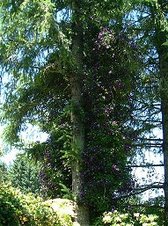Learning Goals:
This webquest was created for a students in third grade and higher. Students will gain a knowledge about the difference between deciduous and conifer trees. They will learn about the different parts of trees and how these parts are used in tree identification. By identifying the trees in their playground they will gain a knowledge of some of the trees that grow naturally in the pacific northwest. Students will also get a chance to practice taking notes, using the Internet to gather information, and typing in a word processor program.
Prior Knowledge:
Before starting the webquest students need to know how to use a word processor program. They also need to understand how to write a paragraph. I think that it will take students about six and a half hours total to complete this webquest. I would suggest spending one hour a day in the computer lab for the first four days of the week. On Friday, I would have students complete the final portion of the webquest. The tree identification, writing, drawing, and presenting of the final project should take about two and a half hours.
Teacher Preparation:
Before doing the final portion of the project, the teacher needs to divide the playground into sections. There should be one section per group with about five trees per section. This can be modified depending on the amount of trees in your playground. The teacher also needs to make a map of the playground on a large sheet of paper.
Grading:
The grading is done on a 1-5 scale, 1 being poor and 5 being excellent. Students will be graded on the activities completed in the "Deciduous or Conifer?", "Basic Tree Identification", and "Tree Term" sections, as well as their final tree identification and presentation.
1: Students are missing more than half of the work required. Work is generally sloppy, with constant spelling and grammatical errors that make it difficult to read. Group did not work well together.
2: Students are missing work from one of the sections. Work is generally sloppy, with constant spelling and grammatical errors that makes it difficult to read. Group did not work well together, or follow all of the directions correctly.
3: Students turned in all of the project components. There are many spelling and grammatical errors, however they generally do not interfere with the reader's ability to understand the final project. The group generally worked well together, followed directions, and used their time wisely, although there may have been a few minor problems.
4: Students turned in all of the project components. There are very few spelling or grammatical errors. The group worked well together, followed directions, and used their time wisely to complete all of the tasks. The completed work shows a lot of effort.
5: This project is excellent! Everything is turned in. There are virtually no spelling or grammatical errors. The project is neat and tidy. The group worked well together, followed all directions, and used their time wisely. The completed work shows a lot of effort. The group clearly went above and beyond the teacher's expectations.
